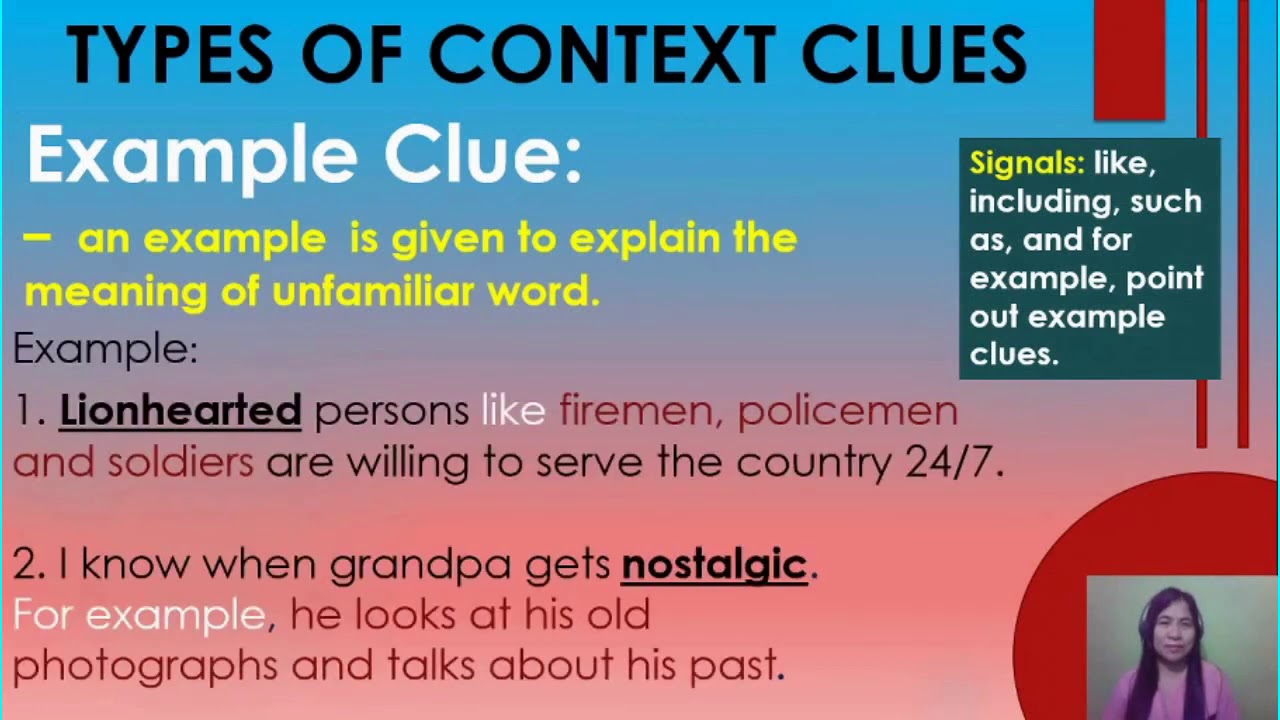Context Clues Examples

When navigating through complex texts, readers often rely on context clues to decipher unfamiliar vocabulary, understand subtle hints, and uncover underlying themes. Context clues are hints or suggestions within the text itself that aid in comprehension, acting as a bridge between the known and the unknown. These clues can manifest in various forms, including definitions, descriptions, synonyms, antonyms, examples, and even the tone of the narrative. Let’s delve into each of these categories with specific examples to illustrate their roles and significance in enhancing our understanding of texts.
Definitions
Sometimes, authors provide direct definitions of terms they use, especially if these terms are technical, less common, or crucial to the narrative. For instance, in a historical novel, the author might introduce a term like “ottoman” and then describe it as “a low stool or a footstool, often upholstered, used for resting one’s feet,” immediately clarifying its meaning within the historical context. This direct approach helps readers grasp the narrative without needing to consult external sources.
Descriptions
Descriptions serve as another form of context clue, particularly useful when authors are explaining abstract concepts or settings. In a science fiction novel, for example, the author might describe a futuristic city, detailing its skyscrapers, flying vehicles, and robotic pedestrians. Through these vivid descriptions, readers can infer the technological advancements, societal structure, and possibly even the themes of innovation and progress that are central to the story.
Synonyms
Authors often use synonyms as context clues to hint at the meaning of less familiar words. For instance, if a text mentions “the philanthropist’s generosity was renowned,” followed by descriptions of her charitable donations and volunteer work, the reader can infer that “philanthropist” refers to someone who donates money or time to help needy causes, even if they were unfamiliar with the term initially.
Antonyms
Antonyms can also serve as effective context clues. If a narrative contrasts two characters, one described as meticulous and organized, and the other as careless and chaotic, the reader can understand the traits of each character by comparing their behaviors and outcomes. For example, “While Emma always planned her trips down to the last detail, her brother would often forget his passport,” illustrating the antonyms of being organized versus being careless.
Examples
Examples given within the text can help clarify complex ideas or terms by showing how they apply in real or hypothetical situations. In an economics textbook, the concept of supply and demand might be explained through the example of a wheat shortage leading to higher prices, making it clearer how these economic forces interact in the real world.
Tone
The tone of the narrative can also act as a context clue, guiding the reader’s interpretation of events or characters. A narrative with a sarcastic tone when describing a character’s lavish spending habits might clue the reader into the author’s critique of excess or materialism, adding depth to the story beyond its literal interpretation.
Case Study: Analyzing a Text
Let’s consider a passage from Jane Austen’s “Pride and Prejudice” to analyze how context clues function in literature. The novel begins with, “It is a truth universally acknowledged, that a single man in possession of a good fortune, must be in want of a wife.” Here, the tone and the societal commentary provide context clues about the themes of marriage, class, and social status that are central to the novel. The description of the single man and the emphasis on his good fortune imply that financial security plays a significant role in relationships, setting the stage for the exploration of these themes throughout the book.
Practical Applications
Understanding and identifying context clues is not only beneficial for readers; it also enhances one’s ability to communicate effectively. When writing, incorporating these clues can make one’s work more accessible and engaging, as they provide readers with a richer understanding of the subject matter. Moreover, in everyday conversations, recognizing context clues can lead to more nuanced discussions and a deeper exchange of ideas.
In conclusion, context clues are versatile tools that enhance our comprehension of texts by offering hints, definitions, and explanations within the narrative itself. By recognizing and leveraging these clues—whether they be definitions, descriptions, synonyms, antonyms, examples, or tones—readers can unlock a deeper understanding of the material, moving beyond the surface level to uncover the intricacies and nuances that make reading such a rewarding experience.
What are context clues, and why are they important in reading comprehension?
+Context clues are hints or suggestions within a text that help readers understand unfamiliar vocabulary, concepts, and themes. They are crucial for enhancing reading comprehension as they provide immediate clarification or insight without the need for external resources, fostering a more engaging and self-sufficient reading experience.
How do authors use descriptions as context clues?
+Authors utilize descriptions to paint vivid pictures in the reader's mind, which can include settings, characters, or objects. These descriptions serve as context clues by providing details that help readers infer meaning, understand abstract concepts, or visualize scenarios, thus facilitating a deeper engagement with the narrative.
Can you give an example of how tone acts as a context clue in literature?
+The tone of a narrative can significantly influence how readers interpret events or characters. For instance, a sarcastic tone when discussing a character's actions might clue the reader into the author's disapproval or critique of those actions, adding a layer of depth to the story and guiding the reader's emotional and intellectual response.
By embracing the role of context clues in reading and writing, individuals can enhance their communication skills, foster a deeper understanding of complex texts, and cultivate a more nuanced appreciation for the intricacies of language and narrative. Whether through direct definitions, vivid descriptions, or subtle hints of tone, these clues enrich our reading experience, making it more engaging, intuitive, and rewarding.


